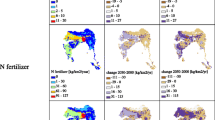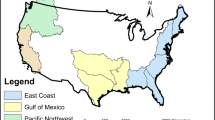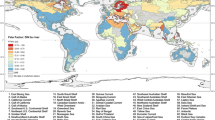Abstract
We examine the global distribution of dissolved inorganic nitrogen (DIN) and particulate nitrogen (PN) export to coastal systems and the effect of human activities and natural processes on that export. The analysis is based on DIN and PN models that were combined with spatially explicit global databases. The model results indicate the widely uneven geographic distribution of human activities and rates of nitrogen input to coastal systems at the watershed, latitudinal, and regional-continental scales. Future projections in a business-as-usual scenario indicate that DIN export rates increase from approximately 21 Tg N yr−1 in 1990 to 47 Tg N yr−1 by 2050. Increased DIN inputs to coastal systems in most world regions are predicted by 2050. The largest increases are predicted for Southern and Eastern Asia, associated with predicted large increases in population, increased fertilizer use to grow food to meet the dietary demands of that population, and increased industrialization. Results of an alternative scenario for North America and Europe in 2050 indicate that reductions in the human consumption of animal protein could reduce fertilizer use and result in substantial decreases in DIN export rates by rivers. In another scenario for 2050, future air pollution control in Europe that would reduce atmospheric deposition of nitrogen oxides in watersheds is predicted to decrease DIN export by rivers, particularly from Baltic and North Atlantic watersheds. Results of a newly developed global PN river export model indicate that total global PN and DIN export by rivers in 1990 are similar, even though the global distribution of the two differ considerably.
Similar content being viewed by others
Literature Cited
Alcamo, J., D. Shaw, andL. Hordijk. 1990. The Rains Model of Acidification. Kluwer Academic Publishers, Dordrecht, The Netherlands.
Alcamo, J., G. J. J. Kreileman, M. S. Krol, andG. Zuidema. 1994. Modeling the global society-climate system: Part 1: Model description and testing.Water, Air and Soil Pollution 76:1–35.
Amann, M., I. Bertok, J. Cofala, F. Gyarfas, C. Heyes, Z. Klimont, M. Makowski, W. Schoepp, andS. Shibayev. 1998. Cost-effective control of acidification and ground-level ozone. Sixth Interim Report to the European Commission. International Institute for Applied Systems Analysis. Laxemburg, Austria.
Baretta, J. W., W. Ebenhoeh, andP. Ruardij. 1995. The European Regional Seas Ecosystem Model, a complex marine ecosystem model.Netherlands Journal of Sea Research 33:233–246.
Billen, G. andJ. Garnier. 1999. Nitrogen transfers through the Seine drainage network: A budget based on the application of the “Riverstrahler” model.Hydrobiologica 410:139–150.
Bleken, M. 1997. Food consumption and nitrogen losses from agriculture, p. 19–31.In J. Lag (ed.), Some Geomedical Consequences of Nitrogen Circulation Processes. Proceedings of an International Symposium, 12–13 June 1997, Oslo. The Norwegian Academy of Science and Letters, Oslo, Norway.
Bouwman, A. F. 1997. Long-term scenarios of livestock-cropland use interactions in developing countries. Land and Water Bulletin 5. Food and Agriculture Organization of the United Nations, Rome, Italy.
Bouwman, A. F., K. W. Vanderhoek, andJ. G. J. Olivier. 1995. Uncertainties in the global sources distribution of nitrous oxide.Journal of Geophysical Research-Atmospheres 100:2785–2800.
Boyer, E. W., C. L. Goodale, N. A. Jaworski, andR. W. Howarth. 2002. Anthropogenic nitrogen sources and relationships to riverine nitrogen export in the northeastern USA.Biogeochemistry 57:137–169.
Caraco, N. andJ. Cole. 1999a. Human impact on nitrate export: An analysis using major world rivers.Ambio 28:167–170.
Caraco, N. andJ. Cole. 1999b. Regional-scale export of C, N, P, and sediment: What river data tell us about key controlling variables, p. 239–253.In J. D. Tenhunen and P. Kabat (eds.), Integrating Hydrology, Ecosystem Dynamics, and Biogeochemistry in Complex Landscapes. John Wiley & Sons Ltd., Berlin, Germany.
Castro, M. S., C. Driscoll, T. E. Jordan, W. Reay, S. Seitzinger, R. Styles, W. Boynton, andJ. Cable. 2000. Assessment of the contribution made by atmospheric nitrogen deposition to the total nitrogen load to thirty-four estuaries on the Atlantic and Gulf coasts of the United States, p. 77–106.In R. A. Valigura, R. B. Alexander, M. S. Castro, T. P. Meyers, H. W. Paerl, P. E. Stacey, and R. E. Turner (eds.), Nitrogen Loading in Coastal Water Bodies: An Atmospheric Perspective, Coastal and Estuarine Studies 57. American Geophysical Union, Washington, D.C.
Cloern, J. E. 2001. Review. Our evolving conceptual model of the coastal eutrophication problem.Marine Ecology Progress Series 210:223–253.
Cogley, J. G. 1994. GGHYDRO, Global hydrographic data, release 2.1. Trent Climate Note 91-1, Trent University, Peterborough, Ontario, Canada.
Dentener, F. J. andP. J. Crutzen. 1994. A three-dimensional model of the global ammonia cycle.Journal Atmospheric Chemistry 19:331–369.
Duce, R. A., P. S. Liss, J. T. Merrill, E. L. Atlas, P. Buat-Menard, B. B. Hicks, J. M. Miller, J. M. Prospero, R. Arimoto, T. M. Church, W. Ellis, J. N. Galloway, L. Hansen, T. D. Jickels, A. H. Knap, K. H. Reinhardt, B. Schneider, A. Soudine, J. J. Tokos, S. Tsunogai, R. Wollast, andM. Zhou. 1991. The atmospheric input of trace species to the world ocean.Global Biogeochemical Cycles 5:193–259.
Food and Agricultural Ogranization. 1992. AGROSTAT-PC. Computerized Information Series. User Manual, Population, Land Use. Production, Trade, Food Balance Sheets, Forest Products. Food and Agricultural Organization of the United Nations, Rome, Italy.
Galloway, J. N. andE. B. Cowling. 2002. Nitrogen and the World.Ambio 31:64–71.
Galloway, J. N., W. H. Schlesinger, H. Levy, II,A. Michaels, andJ. L. Schnoor. 1995. Nitrogen fixation: Anthropogenic enhancement—Environmental response.Global Biogeochemical Cycles 9:235–252.
Heilig, G. K. 1999. China Food. Can China Feed Itself? CD-ROM Version 1.1. International Institute for Applied Systems Analysis, Laxenburg, Austria.
Helsinki Commission (HELCOM). 2001. Evaluation of the Implementation of the 1988 Ministerial Declaration Regarding Nutrient Load Reductions. The Finnish Environment Institute for the Helsinki Commission, Helsinki, Finland.
Holland, E. A., B. H. Brasswell, J. F. Lamarque, A. Townsend, J. Sulzman, J. F. Muller, F. Dentener, G. Brasseur, H. Levy, II,J. E. Penner, andG. J. Roelofs. 1997. Variations in the predicted spatial distribution of atmospheric nitrogen deposition and their impact on carbon uptake by terrestrial ecosystems.Journal of Geophysical Research 102:15849–15866.
Houghton, J. T., L. G. Meiro Filho, J. Bruce, H. Lee, B. A. Callander, E. Haites, N. Harris, andK. Maskell. 1995. Climate change 1994, radiative forcing of climate change and an evaluation of the IPCC 1992 Emission Scenarios. Reports of working groups I and II of the International Panel on Climate Change. Integovernmental Panel on Climate Change, Cambridge University Press, New York.
Howarth, R. W., G. Billen, D. Swaney, A. Townsend, N. Jaworski, K. Lajtha, J. A. Downing, R. Elmgren, N. Caraco, T. Jordan, F. Berendse, J. Freney, V. Kudeyarov, P. Murdoch, andZ. Zhao-Liang. 1996. Regional nitrogen budgets and riverine N and P fluxes for the drainages to the North Atlantic Ocean: Natural and human influences.Biogeochemistry 35:75–139.
Jordan, T. E. andD. E. Weller. 1996. Human contributions to terrestrial nitrogen flux.BioScience 46:655–664.
Kreileman, G. J. J. andA. F. Bouwman. 1994. Computing land use emissions of greenhouse gases.Water, Air and Soil Pollution 76:231–258.
Kroeze, C. andS. P. Seitzinger. 1998. Nitrogen inputs to rivers, estuaries and continental shelves and related nitrous oxide emissions in 1990 and 2050: A global model.Nutrient Cycling in Agroecosystems 52:195–212.
Kroeze, C., S. P. Seitzinger, andR. Domingues. 2001. Future trends in worldwide river nitrogen transport and related nitrous oxide emissions: A scenario analysis.The Scientific World 1:328–335.
Legates, D. R. andC. J. Willmont. 1992. Monthly average surface air temperature and precipitation: Digital raster on a 30 minute geographic (lat/long) 360×720 grid, in Global Ecosystems Database, Version 1.0 Disc (CD-ROM), edited by National Oceanic and Atmospheric Administration. National Geophysical Data Center, Boulder, Colorado.
Lerner, J., E. Matthews, andI. Fung. 1988. Methane emission from animals: A global high-resolution database.Global Biogeochemical Cycles 2:139–156.
Lesack, L. F. W., R. E. Hecky, andJ. M. Melack. 1984. Transport of carbon, nitrogen, phosphorus, and major solutes in the Gambia River, West Africa.Limnology and Oceangraphy 29: 816–830.
Lewis, Jr.W. M., J. M. Melack, W. H. McDowell, M. McClain, andJ. E. Richey. 1999. Nitrogen yields from undisturbed watersheds in the Americas.Biogeochemistry 46:149–162.
Ludwig, W., J. Probst, andS. Kempe. 1996. Predicting the oceanic input of organic carbon by continental erosion.Global Biogeochemical Cycles 10:23–41.
Meybeck, M. 1982. Carbon, nitrogen, and phosphorus transport by world rivers.American Journal of Science 282:401–450.
Milliman, J. D., X. Qinchun, andY. Zuosheng. 1984. Transfer of particulate organic carbon and nitrogen from the Yangtze River to the ocean.American Journal of Science 284:824–834.
Moore, J. G. andR. K. Mark. 1986. World slope map.Eos Transactions of the American Geophysical Union 67 48:1353–1356.
Moutin, T., P. Raimbault, H. L. Golterman, andB. Coste. 1998. The input of nutrients by the Rhône River into the Mediterranean Sea: Recent observations and comparison with earlier data.Hydrobiologia 373/374:237–246.
National Research Council. 2000. Clean Coastal Waters. Understanding and Reducing the Effects of Nutrient Pollution. National Academy Press, Washington, D.C.
Nixon, S. W. 1995. Coastal marine eutrophication: A definition, social causes, and future concerns.Ophelia 41:199–219.
Olivier, J. G. J., A. F. Bouwman, C. W. M. van der Maas, J. J. M. Berdowski, C. Veldt, J. P. J. Bloos, A. J. H. Visschedijk, P. Y. J. Zandveld, andJ. L. Haverlag. 1996. Description of EDGAR Version 2.0: A set of global emission inventories of greenhouse gases and ozone-depleting substances for all anthropogenic and most natural sources on a per country basis and on 1×1 degree grid. RIVM Rep. 771060002/TNO-MEP Rep. R96/119. National Institute for Public Health and the Environment, Bilthoven, The Netherlands.
Olsen, J. S., J. A. Watts, andL. J. Allison. 1983. Carbon in live vegetation of major world ecosystems. ORNL 5862, Environmental Sciences Division Publication No. 1997. Oak Ridge National Laboratory, Oak Ridge, Tennessee.
Prather, M., D. Ehhalt, F. Dentener, R. Derwent, E. Dlugokencky, E. Holland, I. Isaksen, J. Katima, V. Kirchhoff, P. Matson, P. Midgley, andM. Wang. 2001. Atmospheric chemistry and greenhouse gases, Ch. 4.In J. T. Houghton, Y. Ding, D. J. Griggs, M. Noguer, P. J. van der Linden, X. Dai, K. Maskell, and C. A. Johnsson (eds.), Climate Change 2001: The Scientific Basis. Contribution of Working Group 1 to the Third Assessment Report of the Intergovernmental Panel on Climate Change. Cambridge University Press, Cambridge, U.K.
Prospero, J. M., K. Barrett, T. Church, F. Dentener, R. A. Duce, J. N. Galloway, H. Levy, II,J. Moody, andP. Quinn. 1996. Atmospheric deposition of nutrients to the North Atlantic Basin.Biogeochemistry 35:27–73.
Rabalais, N. 2002. Nitrogen in aquatic ecosystems.Ambio 31: 102–122.
Seitzinger, S. P. andC. Kroeze. 1998. Global distribution of nitrous oxide production and N inputs in freshwater and coastal marine ecosystems.Global Biogeochemical Cycles 12:93–113.
Seitzinger, S. P., C. Kroeze, andR. Styles. 2000. Global distribution of N2O emissions from freshwater and coastal marine systems: Natural emissions and anthropogenic effects.Chemosphere—Global Change Science 2:267–279.
Seitzinger, S. P., R. W. Sanders, andR. Styles. 2002. Bioavailability of DON from natural and anthropogenic sources to estuarine plankton.Limnology and Oceanography 47:353–366.
Smetacek, V., U. Bathman, E. M. Nothig, andR. Scharek. 1991. Coastal eutrophication: Causes and consequences, p. 251–279.In R. F. C. Mantoura, J. M. Martin, and R. Wollast (eds.), Ocean Margin Processes in Global Change. John Wiley and Sons, New York.
Smil, V. 2001. Enriching the Earth. The MIT Press, Cambridge, Massachusetts.
Telang, S. A., R. Pocklington, A. S. Naidu, E. A. Romankevich, I. I. Gitelson, andM. I. Gladyshev. 1991. Carbon and mineral transport in major North American, Russian Arctic, and Siberian Rivers: The St. Lawrence, the Mackenzie, the Yukon, the Arctic Alaskan Rivers, the Arctic Basin Rivers in the Soviet Union, and the Yenisei, p. 75–104.In E. T. Degens, S. Kempe, and J. E. Richey (eds.), Biogeochemistry of Major World Rivers. John Wiley & Sons Ltd., New York.
United Nations. 1996. Country population statistics and projections 1950–2050. Report. Food and Agricultural Organization of the United Nations, Rome, Italy.
van Breemen, N., E. W. Boyer, C. L. Goodale, N. A. Jaworski, S. P. Seitzinger, K. Paustian, K. Lajtha, M. Eve, B. Mayer, D. van Dam, R. W. Howarth, K. J. Nadelhoffer, andG. Billen. 2002. Where did all the nitrogen go? Fate of nitrogen inputs to large watersheds in the northeastern USA.Biogeochemistry 57:267–293.
Van Drecht, G., A. F. Bouwman, J. M. Knoop, C. Meinardi, andA. Beusen. 2001. Global pollution of surface waters from point and non-point sources of nitrogen.The Scientific World 1:632–641.
Vitousek, P. M., J. D. Aber, R. W. Howarth, G. E. Likens, P. A. Matson, D. W. Schindler, W. H. Schlesinger, andD. G. Tilman. 1997. Human alterations of the global nitrogen cycle: Sources and consequences.Ecological Applications 7:737–750.
Vörösmarty, C. J., K. P. Sharma, B. M. Fekete, A. H. Copeland, J. Holden, J. Marble, andJ. A. Lough. 1997. The storage and aging of continental runoff in large reservoir systems of the world.Ambio 26:210–219.
Zhang, S., W. B. Gan, andV. Ittekkot. 1992. Organic matter in large turbid rivers: The Huanghe and its estuary.Marine Chemistry 38:53–68.
Sources of Unpublished Materials
IIASA (International Institute for Applied Systems Analysis). 2001. RAINS website. URL:http://www.iiasa.ac.at/~rains. Laxenburg, Austria.
Ludwig, W. Personal Communication. Centre de Formation et de Recherche sur l’Environnement Marin, University de Perpignan, 52 Avenue de Villeneuve, 66860 Perpignan, France.
Author information
Authors and Affiliations
Corresponding author
Rights and permissions
About this article
Cite this article
Seitzinger, S.P., Kroeze, C., Bouwman, A.F. et al. Global patterns of dissolved inorganic and particulate nitrogen inputs to coastal systems: Recent conditions and future projections. Estuaries 25, 640–655 (2002). https://doi.org/10.1007/BF02804897
Received:
Accepted:
Issue Date:
DOI: https://doi.org/10.1007/BF02804897




